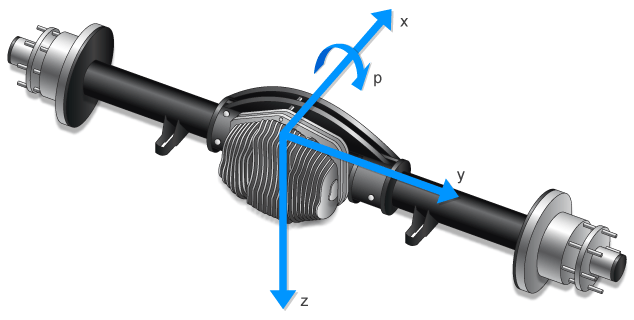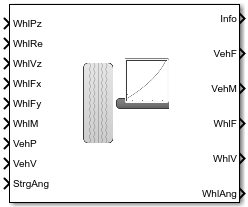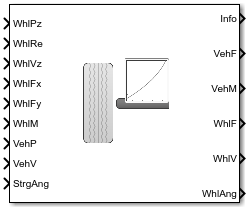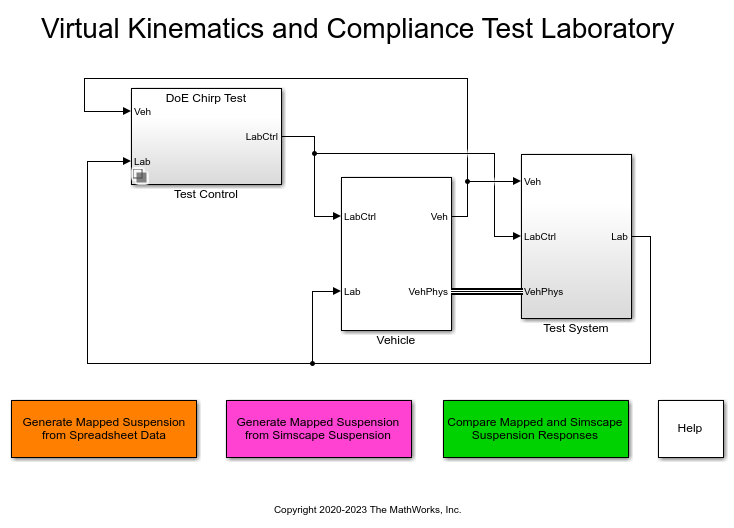Solid Axle Suspension - Mapped
Mapped solid axle suspension
Libraries:
Vehicle Dynamics Blockset /
Suspension
Description
The Solid Axle Suspension - Mapped block implements a mapped solid axle suspension for multiple axles with multiple wheels per axle.
The block models the suspension compliance, damping, and geometric effects as functions of the wheel positions and velocities, with axle-specific compliance and damping parameters. Using the wheel position and velocity, the block calculates the vertical wheel position and suspension forces on the vehicle and wheel. The block uses the Z-down coordinate system (defined in SAE J670) and a solid axle coordinate system. The solid axle coordinate system is aligned with the Z-down vehicle coordinate system, with the x-axis in the direction of forward vehicle motion.

This table describes the settings you can specify for each suspension element.
| Suspension Element | Setting |
|---|---|
Axle |
|
Wheel |
|
The block contains energy-storing spring elements and energy-dissipating damper elements. The block also stores energy via the axle roll angular acceleration and axle center of mass vertical and lateral acceleration.
This table summarizes the block parameter settings for a vehicle with:
Two axles
Two wheels per axle
Steering angle input for both wheels on the front axle
| Parameter | Setting |
|---|---|
| Number of axles, NumAxl |
|
Number of wheels by axle, NumWhlsByAxl |
|
| Steered axle enable by axle, StrgEnByAxl |
|
The block uses the wheel number, t, to index the input and output signals. This table summarizes the wheel, axle, and corresponding wheel number for a vehicle with:
Two axles
Two wheels per axle
| Wheel | Axle | Wheel Number |
|---|---|---|
| Front left | Front | 1 |
| Front right | Front | 2 |
| Rear left | Rear | 1 |
| Rear right | Rear | 2 |
Suspension Compliance and Damping
The block uses a lookup table that relates the vertical damping and compliance to the suspension height, suspension height rate of change, and steering angle. You can calibrate the wheel force lookup table so that steering angle changes from the nominal center position generate a force that increases the vehicle height. Specifically, the block:
Uses | To Calculate |
|---|---|
|
|
To calculate the dynamics of the axle, the block implements these equations. The block neglects the effects of:
Lateral and longitudinal translational velocity.
Angular velocity about the vertical and lateral axes.
For the forces and moments, the block uses lookup tables.
The suspension forces and moments applied to the vehicle are equal to the suspension forces and moments applied to the wheel.
The equations use these variables.
| Fwza,t, Mwza,t | Suspension force and moment applied to the
wheel on axle |
| Fwxa,t, Mwxa,t | Suspension force and moment applied to the
wheel on axle |
| Fwya,t, Mwya,t | Suspension force and moment applied to the
wheel on axle |
| Fvza,t, Mvza,t | Suspension force and moment applied to the
vehicle on axle |
| Fvxa,t, Mvxa,t | Suspension force and moment applied to the
vehicle on axle |
| Fvya,t, Mvya,t | Suspension force and moment applied to the
vehicle on axle |
| Fz0a | Vertical suspension spring preload force
applied to the wheels on axle |
| kza | Vertical spring constant applied to wheels on
axle |
| kwaz | Wheel and axle interface compliance constant |
| mhsteera | Steering angle to vertical force slope
applied at wheel carrier for wheels on axle
|
| δsteera,t | Steering angle input for axle
|
| cza | Vertical damping constant applied to wheels
on axle |
| cwaz | Wheel and axle interface damping constant |
| Rewa,t | Effective wheel radius for axle
|
| Fzhstopa,t | Vertical hardstop force at axle
|
| Fzaswya,t | Vertical anti-sway force at axle
|
| Fwaz0 | Wheel and axle interface compliance constant |
| zva,t, żva,t | Vehicle displacement and velocity at axle
|
| zwa,t, żwa,t | Wheel displacement and velocity at axle
|
| xva,t, ẋva,t | Vehicle displacement and velocity at axle
|
| xwa,t, ẋwa,t | Wheel displacement and velocity at axle
|
| yva,t, ẏva,t | Vehicle displacement and velocity at axle
|
| ywa,t, ẏwa,t | Wheel displacement and velocity at axle
|
| Ha,t | Suspension height at axle
|
| Rewa,t | Effective wheel radius at axle
a, wheel t |
Camber, Caster, and Toe Angles
To calculate the camber, caster, and toe angles, the block uses a lookup table, Galookup, that is a function of the suspension height and steering angle.
The equations use these variables.
| ξa,t | Camber angle of wheel on axle
|
| ηa,t | Caster angle of wheel on axle
|
| ζa,t | Toe angle of wheel on axle
|
| δsteera,t | Steering angle input for axle
|
| zva,t | Vehicle displacement at axle
|
| zwa,t | Wheel displacement at axle
|
Steering Angles
Optionally, you can input steering angles for the wheels. To calculate the steering angles for the wheels, the block offsets the input steering angles as a function of the suspension height. For the calculation, the block uses a lookup table, Galookup, that is a function of the suspension position and steering angle.
The equation uses these variables.
| δwhlsteera,t | Wheel steering angle for axle
|
| δsteera,t | Steering angle input for axle
|
| zva,t | Vehicle displacement at axle
|
| zwa,t | Wheel displacement at axle
|
Power and Energy
The block calculates these suspension characteristics for each axle,
a, and wheel, t.
| Calculation | Equation |
|---|---|
Dissipated power, Psuspa,t |
|
Absorbed energy, Esuspa,t |
|
Suspension height, Ha,t |
|
Distance from wheel carrier center to tire/road interface |
|
The equations use these variables.
| mhsteera | Steering angle
to vertical force slope applied at wheel carrier
for wheels on axle
|
| δsteera,t | Steering angle
input for axle |
| Rewa,t | Axle
|
| f_susp_dz_bp | Vertical axis suspension height breakpoints |
| zwtra,t | Distance from wheel carrier center to tire/road interface, along the vehicle-fixed z-axis |
| zva,t, żva,t | Vehicle
displacement and velocity at axle
|
| zwa,t, żwa,t | Wheel
displacement and velocity at axle
|
Ports
Input
Output
Parameters
References
[1] Gillespie, Thomas. Fundamentals of Vehicle Dynamics. Warrendale, PA: Society of Automotive Engineers, 1992.
[2] Vehicle Dynamics Standards Committee. Vehicle Dynamics Terminology. SAE J670. Warrendale, PA: Society of Automotive Engineers, 2008.
[3] Technical Committee. Road vehicles — Vehicle dynamics and road-holding ability — Vocabulary. ISO 8855:2011. Geneva, Switzerland: International Organization for Standardization, 2011.



